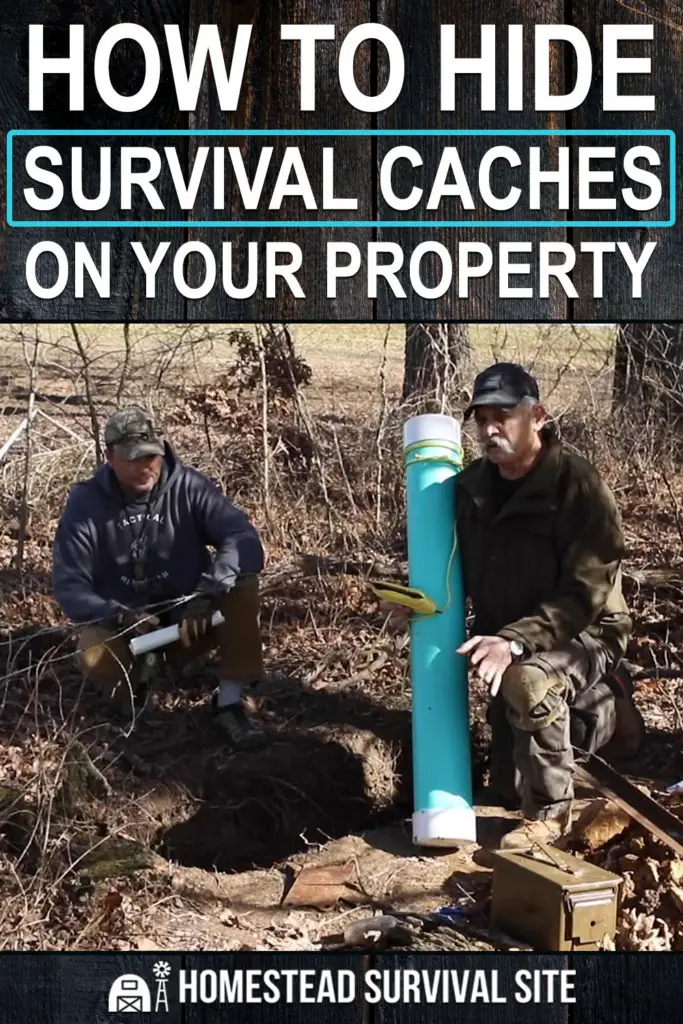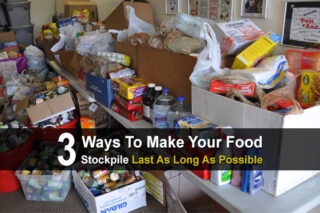Estimated reading time: 6 minutes
There’s an old saying that one shouldn’t put all their eggs in one basket. That statement very clearly applies to our prepping stockpiles. Keeping all of our eggs or any other food items in one basket entails a lot of risk, from a lot of different sources:
- If your home is broken into, they can steal your entire stockpile.
- If your home is overrun in a post-disaster attack, they can really steal your stockpile.
- Government agents could confiscate it.
- A natural disaster that destroys your home would also destroy your stockpile.
The solution, of course, is to avoid keeping all your food in one place. Some people understand this to mean that they should have a supply of food in a pantry off the kitchen, perhaps enough to last a month or two, while their real stockpile is hidden in the basement. That’s okay for foiling someone who is doing a quick look through your home, but it’s not good enough to survive a concerted search. For that, the food needs to be better hidden.
Survival caches are stockpiles of supplies that are hidden away for future use. That idea isn’t limited to prepping alone. Secret military organizations might have caches of weapons or ammunition; so might spies for that matter. Back in the days of the mountain men, it was common for them to establish supply caches so they didn’t have to haul everything around with them. But for preppers, caches are places to put supplies so they still have something to use if they are away from home or their main supply stockpile is gone.
Want to save this post for later? Click Here to Pin It On Pinterest!
When preppers talk about establishing caches, it’s normally in the context of bugging out; establishing caches that can be used during the bug out or in one’s survival retreat. That’s good; but it’s not all that we should do. If our main survival retreat is our home, then we should establish supply caches there as well.
While the main thing that people put in these caches is food, don’t limit your thinking to only food. Anything that is important enough to stockpile, is important enough to put in a cache, especially:
- Ammunition
- Fire starters
- Hygiene supplies
- Medicines
- Toilet paper
- Water filters
Supply Caches Inside the Home
If we’re going to put supply caches in our home, the easier place to put them is inside. There are actually a lot of good hiding places in a home such as boxes of stored stuff in the attic, basement, or garage.
Filling those boxes half full of food and then putting the baby clothes and other things you’re saving on to, makes for a pretty good hiding place. Few searchers would bother to go farther than opening the box and looking inside; and if the first couple of boxes are just old clothes, toys and dishes, they probably won’t bother to search any more.
But there are also things that can be done to make good hiding places in the home, such as:
Putting Food in the Walls – Interior walls in the home have 3-1/2” of dead space, with only a few wires, pipes and heat ducts in them. The drywall can be removed from one side of the wall and food stacked inside. Then the food can be closed back in, by installing new drywall and finishing it.
Few people understand the ductwork in a home. It’s easy to buy additional ductwork to match what’s already there and create a false section of ductwork attached to the original. Just make sure that it looks the same, down to the tape that’s used to attach it being the same color.
As with the ductwork, few people understand the plumbing in a home. If the house has a basement, there’s a 4” diameter drain pipe somewhere. Adding another one that can be filled with food can provide another cache. The trick here is to have it going through the floor above and into the basement floor so it looks like it’s doing something and not just a spare piece of pipe sitting there.
There are many pieces of furniture with unused space inside them, which can be used to store food, such as inside the box (used to be box springs) that mattresses sit on, inside the bottom of sofas and underneath tabletops.
Likewise, the inside of appliances can have extra space that’s not being used, especially clothes washers and dryers.
Supply Caches in the Backyard
All of those places inside the home will work, although they are somewhat limited in the amount of available space. But they all have one big drawback. That is, if something happens to the house, the supply caches will likely suffer the same damage that your stockpile does. That specifically applies to if the house burns down, is flooded, or is destroyed by a tornado.
That’s why it’s important to have some supply caches in the backyard as well. Not only will buried caches be harder to find, but when they are properly done they are pretty much impervious to much of the damage that can happen to a supply cache inside the home.
Many people use PVC pipe to make these underground caches, but even 4” pipe doesn’t allow a lot of room inside the container. There’s another container available at the lumberyard which works much better, holding more than the pipe can – five gallon plastic buckets. With the lid firmly seated on the bucket, it is impervious to insects, rodents and moisture. The only part of the bucket which can be damaged by being underground is the wire bail for the handle; but it’s best to remove that anyway.
Granted, it will still take several five gallon buckets to make a decent cache, but if properly packaged, so as to avoid wasting space, they can hold quite a bit. You can also start a cache out with just one or two buckets, adding more later.
Buckets should be buried underground with the top of the bucket at least two feet below ground level. As you’re filling the dirt back into the hole, put something metal about a foot above the bucket just in case someone goes looking for your cache with a metal detector. That could be some scraps of metal, bits of hardware of even a few coins. If they find your “bait” they’ll hopefully stop digging.
Make Sure You Can Find Your Cache
Regardless of where you put a cache, make sure you keep accurate records of it. We’ve all seen movies and heard stories of treasure maps; well, make your own.
Just make sure that you use two sets of landmarks for each cache and that you’re detailed about directions and distances from those landmarks. Preferably those should be things that can’t simply be moved. In other words a boulder or a street intersection is better than a tree.
Having two sets increases the chances of finding your cache; if one is no longer there, you’ll have the other landmark to use.
Like this post? Don't Forget to Pin It On Pinterest!











I only wish I could bury stuff. It’s just not an option in my area. I still like reading up on the topic, just in case I move.
I found an old dormitory type refrigerator or freezer I don’t know what it was but it still sealed up real good it’s about 3×3 x3 ft so I was able to fill it up dig a hole and put it in the hole it works very good all I got to do is raise the lid up and get what I want
If you must bury your supplies just be aware that our dogs would pick up on arms caches buried under more than a foot of concrete and a couple of feet of soil with all manner of foul smelling additions.
Might one suggest that if you do that you might well consider placing your cache under power lines drain lines even sewer lines as even without the use of dogs the military do have mine detectors which although do not detect too deeply you would be surprised how deep they do detect.
The one problem most searcher have is the tendency to not look up!
Hiding a weapon and indeed Ammo in plain sight was a specialty of the IRA and they were experts at that e.g. a curb stone made of expanding foam and painted concealed an SKS and ammo it was only discovered because of a traffic accident your imagination is your limit just remember dogs are not deterred by speech or tricks they are however very, very fond of Aniseed VERY FOND.